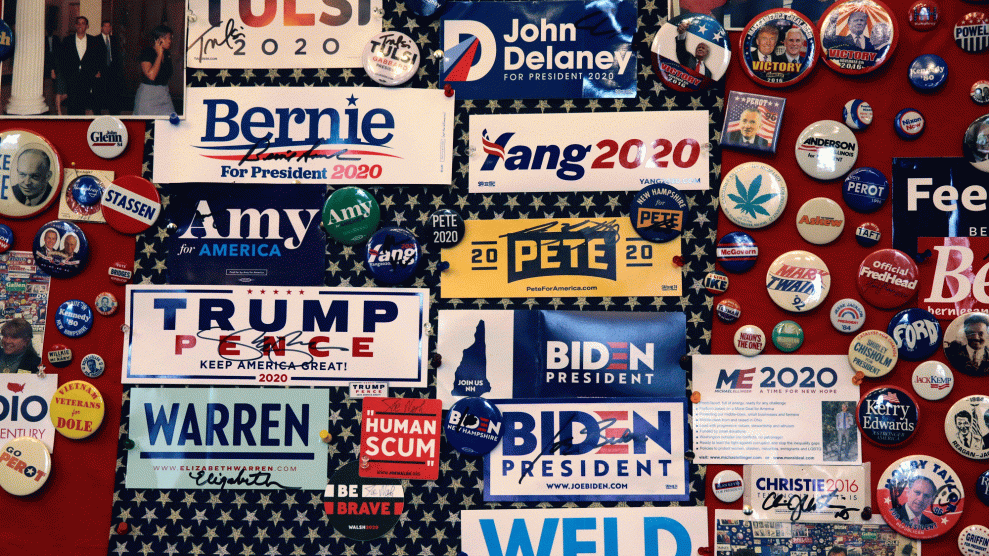
Charles Krupa/AP
For over a year, many pundits and political observers who puzzle over the 2020 Democratic contest have been obsessed with the Lane Theory. It’s a simple notion: There are different lanes in the race—one for moderates, one for progressives, maybe one for a new face, and so on. This has dominated much of the analysis. Think of the Road Warrior movies: Bernie Sanders and Elizabeth Warren are in a death race in the lefty lane; Joe Biden, Pete Buttigieg, and Michael Bloomberg are in their own demolition derby in the centrist lane, with Amy Klobuchar trying to jump the median and get into that mix. That all seems to make sense. Except for this: voters don’t live in lanes.
Meet Michele Vilamarim, a 56-year-old homemaker who lives in Nashua, New Hampshire. On Thursday afternoon, she was at a packed American Legion hall in Merrimack, where Buttigieg was holding a town hall focused on veterans issues. The place was full of Buttigieg supporters. But many attendees, like Vilamarim, were voters who did not know how they are going to vote on Tuesday. And what was most interesting to an outsider (that is, me) was that the undecideds were undecided in a way that did not fit into lanes. One local physicians said she was torn between Buttigieg, Klobuchar, Warren, and Tom Steyer. Seriously. She could go in any direction. How was she going to make a choice? She shrugged: “I have no idea.” A school teacher said she could vote for Biden, Warren, Klobuchar, or Andrew Yang. Really?
Back to Vilamarim. She said she was torn between Biden, Warren, and Buttigieg. Here’s a photo of her:

It’s a pic of her meeting Biden a few days earlier. She spoke to Biden about her mother, whose health insurance carrier recently stopped paying for medicine she needs. The monthly cost of the drugs is $300—and that’s $300 her mother, who lives off Social Security, doesn’t have. As she explained her mother’s plight to Biden, Vilamarim broke down and started sobbing. “He looked me in the eye,” she recalled, “and said, ‘We’re going to help your mother,’ and asked for my information and gave it to an aide.”
That impressed her greatly. As for Warren, Vilamarim was disappointed that at a campaign event the Massachusetts senator walked past her without engaging with her: “It was kind of impersonal.” As for Buttigieg, before he took the stage, she remarked, “I’m going to listen hard. Everyone has great plans. I really want to hear how he will help people as a whole. I care about moral integrity.”
Vilamarim was in no lane. And as Holly Shulman, a longtime Democratic Party official in New Hampshire told me, this is not unusual. “Voters here don’t respond that much to debates and big speeches. If people canvass and make it through the snow to their door, that counts. Small interactions—which may seem imperceptible to those looking at the big picture—can do the trick. It’s all about these interactions.” And it is hard to calculate the accumulation of all these interactions.
That may be particularly so this time around. The Iowa results and the subsequent polls show that the Democratic Party is highly fractured, with many of its voters caring more about dethroning Donald Trump than they do about a specific candidate. Sanders may be leading an overthrow-the-system revolution, and Buttigieg may be leading a let’s-come-together crusade—each claiming he can bring new voters to the polls for the Democrats—yet turnout was down in Iowa. And neither of them assembled a dominant plurality. Will New Hampshire voters turn the party in a decisive direction? And if so, will it have an ideological or thematic component? That is, will they flood a lane?
No one voter can symbolize what’s happening in the Granite State. And there is certainly a set of voters who are torn between Sanders and Warren and another group struggling over Biden and Buttigieg. But this first-in-the-nation primary more resembles the parking lot in a stadium at the end of the big game then a super highway with bright white lines.
Think this:

Rather than this:

As for Vilamarim, after the Buttigieg event, as she was tromping through the ice and snow, she said she was now leaning toward Biden—mainly because he seemed to care about her and her mother. That is, because he got into Vilamarim’s very own lane.















